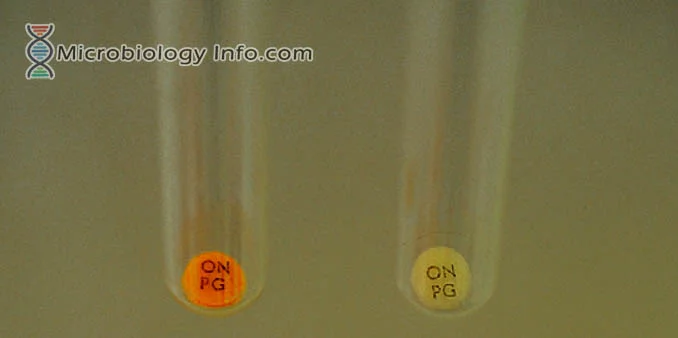The ability of bacteria to ferment lactose depends on two enzymes, permease and beta-galactosidase. Permease allows lactose to enter the bacterial cell wall, where it is then broken down into glucose and galactose by beta-galactosidase. The glucose and galactose can then be metabolized by the bacteria. However, some organisms lack permease and appear as late or non-lactose-fermenters.
The ONPG test is considered to be a very sensitive test for lactose-fermentation. O-nitrophenyl-beta-D-galactopyranoside (ONPG), an artificial substrate, is incorporated into this test and acts as the substrate for the beta-galactosidase to ascertain the particular enzyme activity which subsequently aids in the identification and differentiation of different organisms.
Objective
To determine the ability of an organism to produce β-galactosidase enzyme.
Principle
O-nitrophenyl-beta-D-galactopyranoside (ONPG) is an artificial substrate structurally similar to lactose with the exception that glucose is substituted with an o-nitrophenyl group. Unlike lactose, the substrate O-nitrophenyl-beta-D-galactopyranoside (ONPG) is capable of penetrating the bacterial cell without the presence of permease.
In the broth method of testing, the organism is taken from a medium containing a high concentration of lactose and is inoculated into the ONPG Broth. If the organism possesses beta-galactosidase, the enzyme will split the beta-galactoside bond, releasing o-nitrophenol which is a yellow-colored compound. This indicates a positive test.
In the disk method, the organism to be tested is taken from a medium containing a high concentration of lactose. A dense suspension (turbidity equivalent to a McFarland 3) is prepared. An ONPG disk is added to 0.5ml of the suspension. If the organism possesses beta-galactosidase, the enzyme will split the beta-galactoside bond, creating a yellow color change in the suspension. Organisms with strong beta-galactosidase activity can produce a positive reaction a few minutes after inoculation of the ONPG medium; other organisms may take up to 24 hours.
Media:
- ONPG broth: Na2HPO4 (9.46 g), phenylalanine (4 g), ONPG (2 g), KH2PO4 (0.907 g), per 1000 mL, pH 8.0
- ONPG disk: ONPG Differentiation Disk is prepared by impregnating carefully controlled concentrations of ONPG onto a 0.25 inch diameter filter paper disk.
Method
A. For ONPG disk method
- Place an ONPG disk into a sterile tube and add 0.2 mL saline.
- Heavily inoculate the tube with a loopful of the test isolate.
- Incubate at 35-37°C for up to 4 hours.
- Examine for color change of the disk.
B. For broth method
- Bring test medium to room temperature.
- Inoculate the test medium with heavy inoculum from a pure 18-24 hour culture.
- Incubate aerobically, with loose caps, at 35- 37ºC.
- Examine for a yellow color development at 1 hour.
- If no color change seen after an hour of incubation, continue incubation for up to 24 hours.
Expected Results
- Positive: Development of a yellow coloration (presence of β-galactosidase)
Note: The fluid and disc will turn any shade of yellow if positive for galactosidase enzyme. - Negative: No color development (absence of enzyme)

OPNG test. A, Positive. B, Negative.
Uses
- The test is used in differentiating members of the Enterobacteriaceae and other microorganisms based on beta-D-galactosidase activity.
- The test distinguishes late lactose fermenters from non–lactose fermenters of Enterobacteriaceae.
Limitations
- Cultures that naturally produce a yellow pigment cannot be tested with this media.
- For complete identification biochemical, immunological, molecular, or mass spectrometry testing on colonies from pure culture is recommended.
- All organisms tested must be inoculated from a lactose-containing medium (e.g., TSI or MacConkey).
References
- Tille, P. M., & Forbes, B. A. (2014). Bailey & Scott’s diagnostic microbiology (Thirteenth edition.). St. Louis, Missouri: Elsevier.
- https://catalog.hardydiagnostics.com/cp_prod/Content/hugo/ONPGDiffDisk.htm
- delrio.dcccd.edu/jreynolds/microbiology/2421/lab_manual/ONPG.pdf
- static.lvengine.net/frilabo/Imgs/outros/88005.TechnicalDataSheet.pdf
